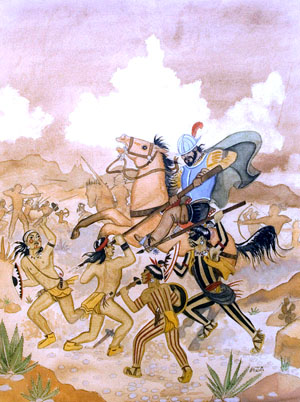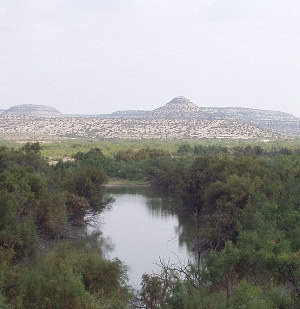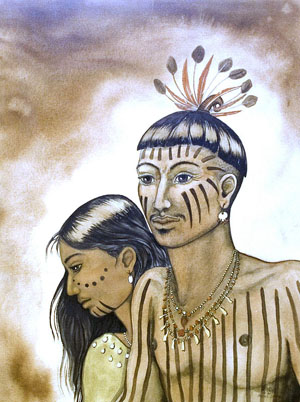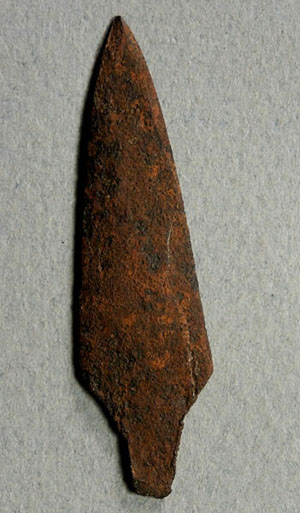|
The Jumano nation’s best documented relationship involves their repeated efforts to initiate a long-term friendship with the Spanish themselves. When first encountered by the Spanish in 1583 the Jumano knew of the Spanish long before they found the members of the expedition returning to Mexico along the Pecos. Slave raids had been made to La Junta, and the Coronado expedition—made up of ca. 300 Europeans, an unknown number of Africans, and more than 1,000 Indian allies from central and west Mexico—had visited both New Mexico and the Southern Plains in the 1540s. Many Indians died during those early encounters.
Scholar Richard Flint states in his 2002 book Great Cruelties Have Been Reported, the 1544 Investigation of the Coronado Expedition, the Coronado expedition “tortured, executed, and terrorized American natives from what is today western Mexico to modern Kansas … destroyed native towns and scattered their populations … stolen and extorted possessions of Indian people … [and] … taken many Indian women for sexual gratification and involuntary service.” One of the testimonies taken in the trial of the Coronado expedition indicated that more than 17 pueblos in New Mexico were burned to the ground and over 150 Indians were burned at the stake. There is little doubt that horrific events and acts were broadly known across modern New Mexico and Texas.
Yet, when the Espejo expedition arrived in the Jumano homelands on the Pecos River in 1583, the Jumano received them in a cordial, friendly manner, not as fearful strangers, as explained in the previous section, Who were the Jumano? This positive beginning would color Jumano-Spanish relations in the years to come.
For several decades, the relationship remained dormant. In the 1620s and 1630s, however, the Jumano made deliberate attempts to court the Spanish as their friends. During these years, the Jumano, in their visits to the Humanas pueblos, made repeated invitations for priests and soldiers to visit their lands and encouraged establishment of missions and presidios there. When the priests agreed to go on the long journey to the Jumano homeland their travel and their visit with the Jumano was peaceful and they returned several times, once even leaving a lone priest among them. During Father Salas’ first visit in 1629, messengers from surrounding nations arrived, again suggesting a peaceful situation. In 1650, the Spanish “stayed [on the Rio de las Nueces—Concho River] for six months because the [Jumano] Indians exhibited such affection for them,” and, in 1654, the Spanish fought at the side of the Jumano against the Cuitoa nation. In each case, the number of Spaniards traveling these long distances to relatively uncharted land was low—sometimes as few as six—suggesting the Europeans felt little concern for their well being.
The motives of the Jumano in courting the Spanish were several. Most of them revolve around a growing Jumano concern for their homelands. First, a severe, multi-year drought was in progress by 1629, the year of the first of these Spanish trips. The Jumano told the Spanish that waterholes had dried up. Officials on the trip later reported that the herds of buffalo “on which these nations sustain themselves” moved north due to the drought and the people were forced to travel away from their homelands to obtain food. Diseases introduced by the Spanish were also beginning to take a toll on the nations on and adjacent to the Southern Plains. As well, the Jumano complained that their enemies were encroaching on their homelands. Repeated pleas of the Jumano for a mission strongly suggest that their purpose was to draw the Spanish to their homelands. It appears that the Jumano had concluded that, in the face of their difficulties, they would benefit from an alliance with the powerful newcomers, the Spanish.
Alignment with the Spanish to preserve their homeland would have been reinforced by the actions of the Spanish in the early years of colonization. Given their physical location on the southern edge of the Southern Plains, the Jumano would have known that the Spanish were anxious to establish trade with plains nomads; they may have counted themselves among these nomads. While the Spanish traded and bartered for hides and other goods, Spanish documents clearly show that slaves to work the silver mines were viewed as an equally important commodity obtained from the Plains. Although the priest Benavides says that the Jumano motive for asking the Spanish to travel to their homelands was conversion to Catholicism, it seems apparent that the Jumano recognized that it would be in their interest to befriend the Spanish by saying they wanted conversion. Perhaps this would allow them to avoid becoming their slaves.
Spanish military activity in New Mexico also must have motivated the Jumano. In 1600, the Humanas pueblos incurred the wrath of the Spanish Governor. They were swiftly punished. As allies of the Humanas pueblos, the Jumanos would have been aware of this punishment and wary of similar conflicts with the newcomers. Over the ensuing decades, the Humanas pueblos were slowly “brought within the fold of the Church” and the Spanish military. To retain their close ties with the pueblos, it would have been in the Jumanos’ best interest to develop amicable relations with the powerful newcomers.
Juan Sabeata and the Mendoza Expedition of 1683
The way Sabeata enticed the Spanish to make the trip to their homelands in 1683 is equally interesting and speaks to how knowledgeable the Jumano were of Spanish interests and how skillful they were as negotiators. Excellent translations of Sabeata’s pleadings can be found in Maria Wade’s 2003 book The Native Americans of the Texas Edwards Plateau 1582-1799. As she notes, both documents illustrate the intimate knowledge this Jumano leader had of Spanish interests in the New World and show a political expertise that would be envied today.
In his discussion with Otermin in 1683, the retiring Governor of New Mexico, Sabeata offered several carrots to the Spanish. First, he noted the Jumano have long been friends of the Spanish, who had been violently expulsed from New Mexico in 1680. This friendship with native peoples would not be taken lightly by the weary people in El Paso. The Jumano were also avowed enemies of the Apache—a group that played a significant role in the Pueblo Revolt, another plus for the Jumano. Sabeata also told the Spanish that if they would come to Jumano lands, they would “profit,” a word that must have resonated with the hungry Spanish. He said they would obtain hides. Moreover, if the Spanish would go with them to La Junta and would help in the wars against the Apache, the people of La Junta “who have many [fields] sown with wheat, corn, beans, and other grains … will give them the necessary food supplies in order that the Spanish can go and help [the Jumano].” Otermin was intrigued enough to draw from his dwindling supplies to give the Jumano a cow, 12 machetes, earrings for women, tobacco and some corn.
When Sabeata returned in October to meet with Cruzate, the new Governor, he was even more loquacious and made some of the same offerings, but added few that he had not offered earlier that year. Again, he told the Governor that the Jumano were their friends and, like the Spanish, they were the sworn enemies of the Apache. He again offered baptisms at La Junta as well as in his lands and even in the lands of the distant Tejas [Caddo] Indians. It is not surprising that he mentioned that the Caddo had a large population and that they grew many crops. The Spanish were hungry. Sabeata also spoke eloquently of the buffalo and the meat and hides that could be had in his lands. All of these offers were appealing to the new Governor, but several other factors helped to persuade him. First, Sabeata listed the nations that would be there to greet the Spanish, and the list is long.
Clearly, Sabeata was listing name after name after name to tell the Spanish that if they were to come to his lands, they would have opportunities to trade with many partners. Whether the Jumano were close or distant friends of all these groups is not known, although some had long been allies. Knowing the Spanish had been stung by the Pueblo Revolt, he anticipated the authorities in El Paso would be interested. Listen to the enticements in Sabeata’s statements about his “good friends” the Tejas [Caddo]:
In the grand kingdom of the Tejas they sow great quantities and have abundant crops and there are many and different fruits; the acorns are the size of a large egg and they produce many grapes seasonally. From where he has been staying in La Junta de los Rios to the Kingdom of the Tejas takes about 15 or 20 days taking the longest road and this witness [Sabeata] thinks, that, from what he has heard, the people of that nation [Tejas} say, they will receive the Spaniards and the friars with great affection and love for they have been waiting for them since Sergeant Major Diego del Castillo [in 1654] and other Spaniards visited them; and the one that came to see Sergeant Major Castillo when he was there [in the Jumano lands] was not their King [of the Tejas] but his Lieutenant because the King never travels and rules with great authority; and this witness knows that among the Tejas there is an Indian of the Teguas [Tigua] nation of those from New Mexico very fluent in the Castilian language who may serve as interpreter if the Spaniards decide to go there. He [the Tigua] has been there for many years and knows the language of the Texas which is a very powerful Kingdom with many people and they are ruled by this King; their Kingdom borders with La Gran Quibira and they communicate so often that almost every day they visit each other. [He also declared] that in the Kingdom of the Tejas so much food is produced that even the horses and the mares are fed on corn.
We know that not all of this was true. The Caddo did not have a central ruler or king and their food supplies varied from year to year. (To learn more about the Caddo, see Tejas: Life and Times of the Caddo.) And, we have reason to suspect that the Caddo may not have been anxious to have the Spanish in their lands. Certainly, their encounters with the remnants of the De Soto expedition in the 1640s were less than pleasant. Nonetheless, they were interested enough to send messages to Sabeata. While the Spanish no doubt were wary of some of what he said, Sabeata implied that while the Spanish starved in El Paso, the populous Caddo were living a life of ease with great quantities of food. Not only that, the Caddo were subtly described to be rich in horses, a not inconsequential commodity. To add a small, final glowing touch, Sabeata mentioned La Gran Quibira, a place located along the Arkansas River in modern Kansas and reputed to have great wealth and one the Spanish had been trying to conquer since the 1540s. One imagines that the hearts of the Spanish listening to Sabeata beat a bit faster at the images he portrayed. As Wade points out, neither El Paso governor had been able to persuade the Viceroy in Mexico to send the guns and food they needed to fight the Apache, re-conquer New Mexico, and eat. The new governor may have decided that new lands with many new Indian groups, lots of buffalo, nuts, and the prosperous Caddo and Quiverans would convince the Viceroy to send funds for guns and food.
Wade also notes that Governor Cruzate had several other problems that would be solved if he sent out an expedition to the Jumano homeland. Perhaps the most serious was the pressure he was getting from Juan Dominguez de Mendoza, a member of a powerful family. Mendoza had lost great wealth in the Pueblo Revolt after spending many decades there. He was upset that efforts to re-conquer New Mexico had stalled and was exerting pressure to do so. At the same time, he had been charged by Spanish officials with disobedience and profiteering, charges which further annoyed him. Learning of Sabeata’s offer, Mendoza volunteered to lead an expedition and pay for some of the costs himself. Governor Cruzate seized the moment: he would be able to reduce the overall costs of the expedition and, at the same time, rid himself of the pressures brought by Mendoza.
December 15, 1683, Mendoza, 17 soldiers, and 3 priests began the journey that would take them down the Rio Grande to La Junta and from there northeast to the Jumano homeland. Wade provides a superb translation of the daily journal of the trip. To date, no map of the journey has been found although Mendoza stated in a testimonial that he had made one. Wade provides her own projection of the route in her book, although other interpretions are possible.
While some of Sabeata’s claims in El Paso were exaggerated, others were not, such as the claim that the Jumano had a large number of allies. Eighteen nations traveled with Mendoza and the Jumano in west-central Texas and it was said that 37 nations were expected in the Jumano homelands. Likely not all were close friends and some did not come, but together they suggest that the Jumano had extended their hand in friendship to many other nations, some potentially powerful. While many names in the list are obscure, a few are recognizable. The Huicasiques (Hueycasales), Bobidas, Injames, Humez, Bibis [Bibits], and Puchames were among the small nations east of the Jumanos’ homeland. In subsequent years, the Jumanos were often in the company of one or more of these nations. Others in the lists were the Yoyehis, Ascanis, and Isconis, Wichita groups who in the 17th century were migrating south into Texas from original homelands in Kansas and Oklahoma.
Apache and French Threats
The Jumano concern for their homelands was certainly not exaggerated. The Apaches had plagued the Mendoza expedition, and a few years later the priest Posada stated that “this nation [the Apaches]...is the owner and possessor of all the plains which they call Cibola” and recommended construction of a presidio on the Rio de las Nueces, stating: “[It] will undoubtedly have the support of the Jumana nation....because it is their land which the Apacha nation took away from them and whom they hold as enemies.”
Despite Posada’s statements that the Apaches had taken the homelands of the Jumanos, slightly later documents suggest that the Jumanos continued to maintain at least a toe-hold on those lands. In 1688, General Retana traveled four days northeast of La Junta to meet with the Indians that were to bring him word of the French on the Gulf Coast, and he was greeted by Juan Sabeata, “who was very glad to see the Spanish in his lands”. Four days travel northeast of La Junta would place the meeting in the vicinity of the Pecos River. Later, when encountered along the eastern edge of the Edwards Plateau in 1691, the Jumanos stated that their saddles were acquired in a war with the Apaches and that their homeland was the “rio salado” or Pecos River.
Nonetheless, despite their best efforts to establish a close relationship with the Spanish, Spain’s interest in the Jumano waned after discovery of French intruders on the Gulf Coast. Spain had a far greater interest in maintaining a hold on Texas, and Spanish attention shifted to east Texas and the Gulf Coast. (See Los Adaes and Fort St Louis.) There are indications that the Jumano continued to pursue an alliance with the Spanish as they undertook a series of trips to and from the Caddo region and the Gulf Coast. From these trips, they brought information sought by the Spanish. In one account, they brought news of “a dark skinned person with an arquebus living near the Caddo,” information on the slaughter of the French by the natives, and other details of events in those far lands. After 1700, Jumano hopes dwindled.
Jumano Symbols
Documents indicate that Jumano efforts to align themselves with the powerful newcomers (the Spanish) included efforts to redefine symbols of their ceremonial and religious activities. Familiar with the symbols of Catholicism by the time of Salas’ visit, the Jumano apparently incorporated some of these symbols into their own belief systems. They received the Spanish “in procession, with two crosses.” When the priests, in turn, took out their crucifixes, “each person came to kiss them and venerate them as if these people were Christians of long standing.” They [the Jumano] also kept their eyes on their feet “something that we all admired.” In one of the more remarkable events of seeking conversion, the Jumano claimed to have been visited by “a woman like the one painted in the church [at the Tompiro mission, i.e., the Virgin Mary] who spoke to each one of [the Jumano] in their own language saying that they should come to seek the priests to ask them to teach and baptize them, and to not be lazy. This woman was dressed...as the woman in the painting but her face was not like [the one at the church].” The Spanish came to believe that this apparition, who came to be known as the Lady in Blue, was the Spanish nun and mystic Maria de Jesus de Agreda who lived from 1602-1673. Much has been written about this mysterious figure, including a recent novel by Spanish writer Javier Sierra, The Lady in Blue (2007).
Other Jumano expressions of Christianity include touching the habit of Fray Juan de Larios in 1675, and kissing the habit of Fray Nicolas Lopez in 1683, symbolically touching a form of clothing worn by few and therefore, perhaps, powerful individuals. These mannerisms impressed the priests as did the Jumano request to learn all aspects of Christianity.
The Christian cross was another prominent symbol adopted by the Jumano. A large cross of nine colors, likely erected during the Spanish visits of 1629 and 1654, had rotted and fallen down by the time Sabeata persuaded the Governor to send the expedition to his homeland in 1683. Nonetheless, stories about it were told to the Spanish over the campfires. It was said that many visitors to the Jumano lands had stopped to see this important symbol. Even Jumano enemies had fallen under its spell, and it was claimed that the power of this religious symbol had aided the Jumano’s success in a raid on an enemy camp of 78 tents. The cross was also given credit for halting an Apache raid on their camps. Spying the tall cross, Apache raiders turned back. In 1691, a cross was again prominently displayed among the Jumano and their friends when they were encountered along the eastern edge of the Edwards Plateau. Led by Juan Sabeata, several nations told the Spanish they had “cared for the cross for many years.”
Incorporation of Spanish religious expressions was not unique to the Jumano. Certainly, it was encouraged by the Spanish. Baptism, crosses and other Christian symbols appeared elsewhere as symbols to deter enemies. On their trip down the Rio Grande to La Junta, Mendoza and his party encountered several camps of Suma, and he wrote: “they asked my favor and help against our common enemy, the Apaches...[who] would not let them stay in their homelands....I told them I would help them on my return trip, and in the crest of a hill I put a cross.” Jumano adoption of Spanish iconography, therefore, was not unique, but, at least in the minds of the Spanish, the Jumano use of Christian symbols underscored the sincerity of their appeal for a long-term alliance.
Of course these events can be interpreted in various ways. The Jumano may well have desired conversion and some may have genuinely appreciated the teachings of the priests. Others may have felt that these powerful newcomers were a force that had, to that point, been able to do pretty much whatever they desired. So if the Spanish believed in this Christian God, perhaps conversion was a good thing. Perhaps it would hold them safe. On the other hand, the Jumano were well aware of the military potential of these newcomers—something not to be taken lightly. So it is possible that they sought to incorporate Christian symbols and ceremonies into their own beliefs to both keep themselves safe and to avoid Spanish ire.
Whether these symbols were embraced as a belief system is not clear. We know that the Jumanos realized that their world and their homelands were threatened. By extending their hands to the Spanish in friendship, maintaining alliances with old friends, and by adopting Spanish symbols and ceremonies, the Jumano appear to have been seeking an alliance with a new nation, perhaps with the hope that the newcomers would help them in troubled times and afford them a de facto aura of protection against the Apaches.
Ultimately the strategy—whether motivated by a true desire for conversion or by a need for a powerful friend—was unsuccessful. Their friendship with the Spanish did not enable the Jumano to hold on to their homeland for long. Yet, like others before and after them, they had to try. In their 1996 book Paths of Life American Indians of the Southwest and Northern Mexico, Thomas Sheridan and Nancy Parezo describe such changes: Native Americans “have defined and redefinded themselves in response to changing natural and human environments....[and] have continually incorporated new symbols, ceremonies, and material items into their cultures as they have interacted with one another and the European newcomers.”
Jumano Enemies become Friends
After Mendoza and the priests returned to El Paso in 1684 after their journey to the Jumano homelands, the Jumano seem to have devised a new strategy for survival. In the opening years of the 18th century, there is almost no documentary evidence of the Jumano. When they resurface in the second decade of the 1700s, the records indicate that the Jumano had dramatically shifted their alliances. Surprisingly, they were now allied with the Apache, at least some of whom were now living in the Jumano homelands. At this time, Jumano were fighting along side their former enemies to protect those same homelands. Reasons for this dramatic reversal are not well described in the documents, but appear related to the abandonment of Spanish interest in their lands, the continued Spanish slave raids, a reduction in the bison herds, and the presence of a new enemy on the horizon: the Comanche.
The first indication of the change came in 1716 when Fray Ramirez, a priest at La Junta, was invited by an Apache “to go with him to his lands...which are in the plains, are very large, and where there are fat grapes, fruit trees of the Spanish and a river where there are many conch shells with pearls ... and a River Colorado ... where many times the Spanish had come with the Jumano Indians”. (Colorado in Spanish means “reddish,” and the reference is no doubt to the Pecos River, not the river today known as the Colorado.) At first blush, the statement suggests that the Jumano had been exterminated by the Apache. However, in 1729 the term "Apaches Jumanos" was employed in a report by the Captain at San Juan Bautista located down the Rio Grande from Laredo: “Indians of the nation Apaches Jumanes and Pelones...are the most numerous that exist, and these [nations] are molesting the presidio of San Antonio de Balero [San Antonio] and this presidio of San Juan Bautista.” Four years later, testimony detailed crimes of the Apaches, Pelones, Jumanes, and Chenttis. At approximately the same period of time, reports place the Jumanos east of Pecos Pueblo, engaging in hostile activities similar to the hostile actions of the Apache. Taken together, these statements indicate that the Jumanos had abandoned efforts to forge an alliance with the Spanish, and had turned instead to their former enemies, the Apaches.
At first, the Jumano solution seems contradictory, but the Jumano’s options were limited: survival or death. The solution was practical. By joining the Apache, the Jumano were able to maintain a presence on their lands on the Pecos for a few more decades. By the late 1700s the Jumanos disappear from the Spanish records and no longer survived as a separate people. While it is likely that traces of Jumano blood (biological heritage) still exist among the Mescalero Apache and among some borderlands Mexicans and Mexican Americans, Jumano culture has long been gone. That said, there is a modern movement among some of the residents of Redford and Presidio, Texas to call attention to what they believe is their rightful cultural heritage. Perhaps the “Jumano-Apache” tribe may one day live again. |

Artist’s depiction of a pitched battle between Spanish horsemen and the native peoples of La Junta. While the painting is somewhat fanciful, the La Junta native groups were raided many times by Spanish slavers seeking laborers to work in silver mines and agricultural fields located some 200 miles to the south. In response to continued raids, the people of La Junta revolted several times in the late 17th and early 18th centuries. At times this forced the small contingent of Spanish missionaries to retreat to the south to Parral. This 1994 painting by artist Feather Radha can be seen in Restaurante Lobby's OK in Ojinaga, Mexico. Courtesy Elsa Socorro Arroyo.  |

Mines being worked by Spanish slaves. Many native peoples in the Trans-Pecos were captured by the Spanish to work silver mines in northern Mexico from the late 16th through 18th centuries. The image shown depicts a scene in Peru. |

Drawing of Juan Sabeata’s cross as it appears in Spanish documents.
Adapted from Wade 2003, Figure 4.2.
|
|
The Nations Said to be Waiting for the Jumano in their Homelands
As told by Juan Sabeata to New Mexico Governor Cruzate in 1683
See full list.
|

Several Spanish expeditions visited Jumano Camps along the Pecos River in the 1680s. This area lay within the western part of the Jumano homeland. Photo taken near Sheffield in Crockett County by Susan Dial.  |
Nations that Traveled with Mendoza in 1683-1684
Jumanos
Ororosos
Beitonijanes
Achubales
Gediondos
Isuchos
Caulas
Suajos
Ylames
Cunquebacos
Quicuchabes
Los que asen Arcos
Toremes
Hinehis
Quitacas
Siacuchas
Hanasines
Cujalos
Cujacos
|

The “grand kingdom of the Teyas” who Sabeata bragged about knowing, were one of the Caddo-speaking peoples in east Texas who lived in villages, sometimes quite large such as the one depicted here of a settlement on the Red River, produced by the Spanish expedition of 1691-1692, led by Terán del Rio.. The map shows that the community consisted of small farmsteads or extended family compounds, each depicted as being surrounded by rows of trees or bushes. On the left is a mound with a "templo" on top. The settlement shown is believed to have stretched along several miles of the Red River. Original (uncolored) map in the Archivo General de Indias, Seville.  |

Artist depiction of a Jumano couple. Both are painted or tattooed, a characteristic of Jumano people. The man’s elaborate headdress and shell and stone ornaments might be similar to that worn by an Jumano leader on a ceremonial occasion. This 1994 painting by artist Feather Radha can be seen in Restaurante Lobby's OK in Ojinaga, Mexico. Courtesy Elsa Socorro Arroyo.  |

Metal arrow point from campsite (41CX209) in the Pecos River valley in Crockett County. This area lay within the Jumano homeland and it is a reasonable candidate for a Jumano campsite. Nearby was a small hearth, chipped stone hide scrapers, and a nodule of red ocher. Thus far archeologists have yet to convincingly identify known archeological sites with the Jumano—mainly because the archeological signature of the Jumano was probably quite similar to that of both earlier and contemporary groups. TARL Collections, photo by Steve Black.  |

Glass trade beads from the Davis Hackberry Spring site in Sterling County in the northwestern Plateaus and Canyonlands region may be Spanish trade goods. A fragment of possible Spanish chain mail was also found at this site, which is located within the eastern Jumano homelands. Photo by Larry Riemenschneider.  |

House near Redford, Texas. There is a modern movement among some of the residents of Redford and Presidio, Texas to call attention to what they believe is their rightful cultural heritage. Perhaps the “Jumano-Apache” tribe may one day live again.  |
|








